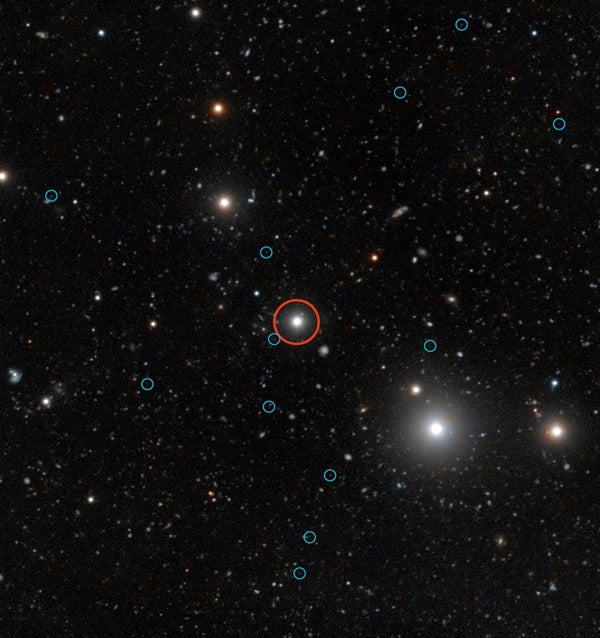Dark galaxies are small gas-rich galaxies in the early universe that are inefficient at forming stars. They are predicted by theories of galaxy formation and are thought to be the building blocks of today’s bright star-filled galaxies. Astronomers think that they may have fed large galaxies with much of the gas that later formed into the stars that exist today.
Because they are essentially devoid of stars, these dark galaxies don’t emit much light, making them hard to detect. For years, astronomers have been trying to develop new techniques that could confirm the existence of these galaxies. Small absorption dips in the spectra of background sources of light have hinted at their existence. However, this new study marks the first time that such objects have been seen directly.
“Our approach to the problem of detecting a dark galaxy was simply to shine a bright light on it,” said Simon Lilly from ETH Zurich, Switzerland. “We searched for the fluorescent glow of the gas in dark galaxies when they are illuminated by the ultraviolet light from a nearby and very bright quasar. The light from the quasar makes the dark galaxies light up in a process similar to how white clothes are illuminated by ultraviolet lamps in a night club.”
The team took advantage of the large collecting area and sensitivity of the VLT, and a series of very long exposures, to detect the faint fluorescent glow of the dark galaxies. They used the FORS2 instrument to map a region of the sky around the bright quasar HE 0109-3518, looking for the ultraviolet light that is emitted by hydrogen gas when it is subjected to intense radiation. Because of the expansion of the universe, this light is actually observed as a shade of violet by the time it reaches the VLT.
“After several years of attempts to detect fluorescent emission from dark galaxies, our results demonstrate the potential of our method to discover and study these fascinating and previously invisible objects,” said Sebastiano Cantalupo from the University of California, Santa Cruz.
The team detected almost 100 gaseous objects that lie within a few million light-years of the quasar. After a careful analysis designed to exclude objects where the emission might be powered by internal star formation in the galaxies, rather than the light from the quasar, they finally narrowed down their search to 12 objects. These are the most convincing identifications of dark galaxies in the early universe to date.
The astronomers were also able to determine some of the properties of the dark galaxies. They estimate that the mass of the gas in them is about 1 billion times that of the Sun, typical for gas-rich, low-mass galaxies in the early universe. They were also able to estimate that the star formation efficiency is suppressed by a factor of more than 100 relative to typical star-forming galaxies found at similar stage in cosmic history.
“Our observations with the VLT have provided evidence for the existence of compact and isolated dark clouds. With this study, we’ve made a crucial step towards revealing and understanding the obscure early stages of galaxy formation and how galaxies acquired their gas,” said Cantalupo.
The MUSE integral field spectrograph, which will be commissioned on the VLT in 2013, will be an extremely powerful tool for the study of these objects.










